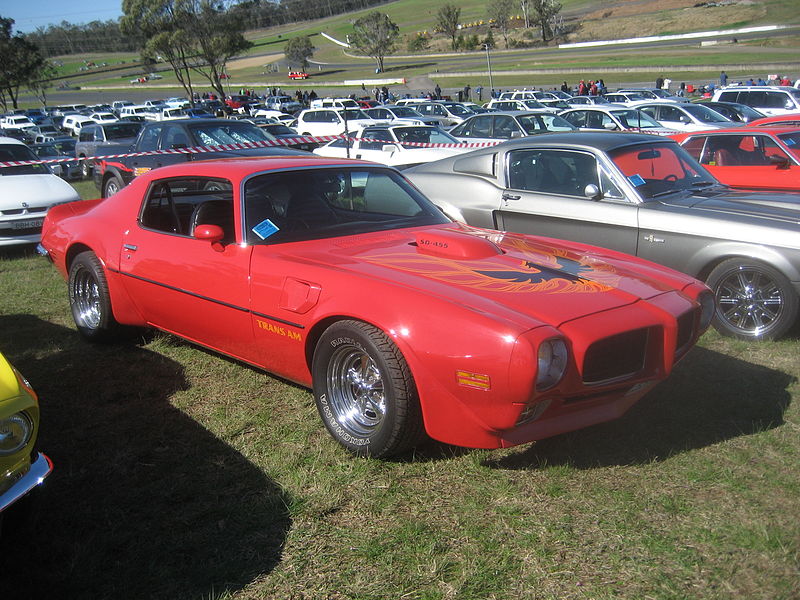Unlikely Hero: Pontiac Firebird Trans Am and Formula SD-455
Forty years ago, Pontiac bookended the muscle car market with one car that many consider to be a low point of the genre, and another that proudly parks in the upper echelon alongside Hemis, LS6 Chevelles and Boss Mustangs.
The Pontiac Division retired the GTO on a low note in 1974, making it an option package that dressed up the Nova-clone Ventura model with a Trans-Am style shaker hood, beefier suspension and a 350 4-barrel engine. It was a pretty good $195 upgrade, but it probably should have used the Sprint name that was applied to different Ventura trim packages.
At the other end of the spectrum, the Super Duty 455 engine option for the Firebird Formula and Trans Am continued after a late entry in 1973. The engine immediately acquired a near-mythical persona that has never faded. Even Car & Driver, in its road test of a 1973 SD-455 Trans Am, said, “…the best compliment bestowed on the Firebird is the fact that, even in its own time, it is becoming a collector’s item.”
The SD-455’s arrival surprised the media and enthusiasts who had been awaiting the demise of performance cars in a catalytic cataclysm of emissions regulations. Pontiac Special Projects engineer Herb Adams and his team developed their new performance engine as if it really would be their last. To underscore the point, they resurrected the “Super Duty” label Pontiac had used in its early ’60s racing efforts.
Even without the SD-455, the 1973-1974 Firebird offered solid performance choices. In the wake of lowered compression ratios and other tweaks to accommodate unleaded gas, the Trans Am’s standard 400 4-barrel was a respectable piece with 225 net horsepower. A 250-horse 455 was an option. The ’74 Camaro Z/28 matched that with its lighter L-82 350, but the Poncho packed a bigger torque punch.
As Car & Driver pointed out in its 1973 road test, Pontiac was able to certify the SD-455 under the umbrella of the 455 family. Yet, the SD-455 was something very special, not just a warmed-over 455. Into a reinforced block went a nitrided crankshaft, forged pistons and forged connecting rods. Compression was low at 8.4:1, but new oval-port heads conspired with low-restriction intake, a big Quadrajet carb and a 2.5-inch dual exhaust system to flow better than any 1974 Detroit engine had a right to.
The shaker hood scoop could be made functional by popping out the metal block-off plate that was used to help the car pass noise regulations. Doing so chopped two tenths off the quarter-mile and added 3 mph to the trap speed, Car & Driver reported — and loudened the intake roar, of course.
Car & Driver blasted the Trans Am SD-455 down the quarter-mile in 13.75 seconds at just shy of 104 mph. In the same test car, Hot Rod magazine did the deed in 13.54 at just over 104. No other American car was close in 1973-1974.
Were the numbers for real? The engine in the 1973 magazine test car was a prototype, likely built under Adams’ watchful eye. It also had the old Ram Air IV camshaft that did not make it into the production SD-455 engine. The 310-net horsepower rating seen in the 1973 magazine features dropped to 290 in production cars, which still made the SD-455 the highest-rated V-8 from Detroit in 1973 and 1974.
Motor Trend’s results with the same car were quite different: 15 seconds at 98 mph, about the same as a Z/28 could muster. Different drivers and different conditions could account for some of the gap. The magazine test car had an automatic and a 3.42 axle ratio, while cars sold with air conditioning came with a taller 3.08 ratio.
You can be sure that some SD-455 owners did whatever was needed to score a 13-second time slip. There weren’t many owners, though. Just 1,296 1973 and 1974 Firebirds got the SD-455, 101 of them Formulas and the rest Trans Ams. Most were automatics.
In retrospect, Pontiac didn’t need the SD-455, which added more than $500 to a Trans Am’s price. In fact, it was a $55 option — the huge Firebird hood decal called the “screaming chicken” by some that debuted in 1973 — that usually gets credit for putting the Trans Am in the public’s eye and boosting sales from 1,286 in 1972 to 4,802 in 1973, and then to 10,255 in 1974.
The more that bird grew, the higher Trans Am sales flew, even as performance declined. In 1975, when the top motor was a mild 200-hp 455, sales shot past 27,000. Most had the hood decal.
Even if the SD-455 engine contributed little to the Trans Am’s popularity, it earned Pontiac lasting respect for making a heroic effort.
The 1973 Trans Am SD-455 magazine car resurfaced in Australia many years later, missing its original engine and sporting a right-hand drive conversion, according to a January 2013 article in High-Performance Pontiac magazine. It even has its own Facebook page.


